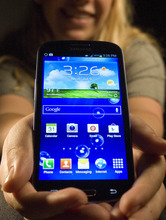This is an archived article that was published on sltrib.com in 2012, and information in the article may be outdated. It is provided only for personal research purposes and may not be reprinted.
About every two months, I edge closer to dumping my iPhone and buying a new Android phone. They're becoming that good.
But the very notion Android handsets are getting much better more quickly is also what makes me ultimately not buy one. As someone who wants the latest, most advanced features in a mobile phone, it would be maddening for me to buy the greatest in Android phones, only to see it bested by a newer model two months later. At least with an iPhone, you know you have the best one for a year.
Yet the new Android handset du jour has seduced me like no other. The Samsung Galaxy S III, which was just released for AT&T, Verizon and Sprint for $199 with a two-year contract, is a sleek, lightweight and beautiful smartphone. I was able to play with one courtesy of AT&T, and here's what I thought.
Design • At 4.8 inches diagonally, the Galaxy S III has one of the largest screens available for a mobile phone, save for the hilariously huge 5.3-inch screen on the Samsung Galaxy Note. And with a 1280-by-720-pixel resolution, the S III's screen is crisp, vibrant and has a deep contrast thanks to Super AMOLED technology. Graphics and text, however, are not quite as smooth as on the iPhone retina display (largely because the iPhone's screen is much smaller). The phone's brightness was a bit dim, and I had to keep it at the highest setting, which was a big battery drain.
At first glance, the S III looks big, but it doesn't feel that way in the hand because of its thinness (8.6 mm thick) and how light it is (just 4.07 ounces). In terms of form factor, the phone felt the best in my hand of any model since the latest Motorola RAZR.
It's housed in a nice metallic blue or white case with a brushed look, although it's made of plastic and is more susceptible to scuff marks (I accidentally dropped the phone and it left huge marks on the corners).
Finally, the physical function keys on the bottom — including the settings and back keys — have been replaced with touch-sensitive buttons that light up only when used, a nice touch that reduces clutter on the phone.
Performance • One area where Android phones have consistently lagged behind the iPhone has been in the speed with which they call up and run apps, and how smoothly the screens scroll and zoom in and out. The advantage Apple has is that it produces both the hardware and the operating system for the iPhone, making sure that each is optimized for the whole experience. Several hardware manufacturers produce Android handsets, and Google creates the Android operating system. So the OS doesn't work as well across all phones.
Yet the Galaxy S III has been the smoothest and most responsive Android phone I've used, thanks to its speedy dual-core processor, although it's overall performance still is not as quick and snappy as the iPhone.
Because of the phone's thinness, the battery was barely sufficient, giving me less than a day's charge under normal use. I would have sacrificed a bit of the phone's thinness for a bigger battery.
Call quality was fine, and 3G connectivity was fast on AT&T's network. Unfortunately, I wasn't able to test a 4G LTE connection because AT&T's network is not up and running in Utah yet.
Operating system • The S III uses the latest available Android OS, dubbed Ice Cream Sandwich (a newer version called "Jellybean" is not out yet), and there are a few nice enhancements.
For one, it uses facial recognition to unlock the phone. Instead of swiping your finger or typing in a code, it can see your face with the front camera to unlock the phone. It worked well and was quicker than I expected under most lighting conditions.
There's also new motion-based features added, including the ability to make a call just by lifting the phone. And you can display picture-in-picture video in a small stamp-sized frame in the corner of the screen so you can perform other tasks on the phone while it plays.
Whether you will use these features or not is up to you, but they're all welcome functions — including turn-by-turn navigation and manual camera controls — that are not yet on the iPhone.
But like the iPhone, the Galaxy S III has Samsung's own version of Siri, the voice command feature in which you can get all kinds of information by just asking the phone. And like the iPhone, it sometimes works well and sometimes does not.
Camera • The S III sports an 8 megapixel rear camera and a 1.9 megapixel front-facing camera. Generally, the pictures and video were good, although the auto-focus on the rear camera seemed slow and unresponsive at times, often producing blurry pictures. With a "burst mode," the camera can shoot up to three photos per second, and it does include a macro setting for extreme closeups that the iPhone doesn't have.
Still, in terms of overall quality and crispness, the iPhone camera produces the best pictures and video of any mobile device I've used.
That said, the Samsung Galaxy S III is the best Android phone you can buy today, and it proves that the Android platform continues to innovate at a brisk pace, leaving the iPhone behind in many ways. Now if only that progress could stop long enough for us to enjoy those features without the phone feeling obsolete.
Google+: +Vincent Horiuchi



